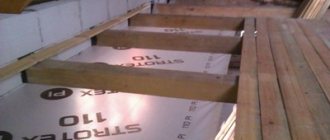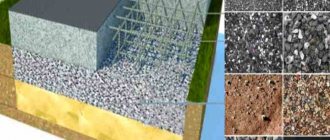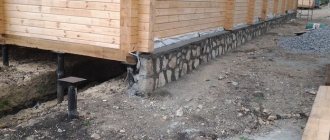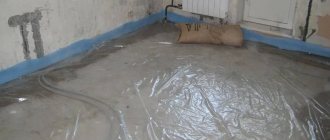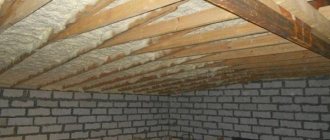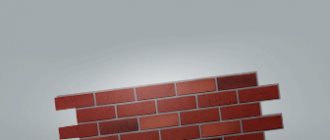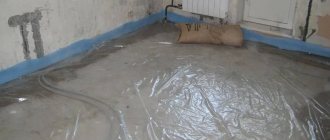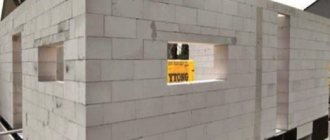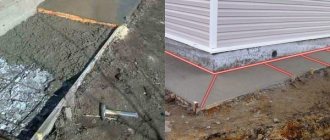The main types of materials used for vapor barrier of a wooden house
Using a vapor barrier can significantly extend the life of a wooden house.
The following types of vapor barrier can be selected on the market, which will provide reliable protection of building structures. Membranes containing a film made of non-woven fiber. It effectively absorbs moisture. There is no need to leave any gap when installing this membrane.
Diffuse films - this material provides high-quality ventilation.
Multilayer film is the optimal solution for providing vapor barrier to rooms that are not heated in winter.
Multifunctional films - the name speaks for itself, in addition to steam, this material protects walls from wind, rain, etc. They are widely used in the construction of ventilated facades.
film for home insulation
Concrete and film
There is a basement of the house, it is covered with stone-like plaster. Uneven, cracking crap. You need to somehow attach a vapor barrier to it. How? Suggest options on how to fix it?
There is such a moisture-resistant sealant - Sikaflex 221. Apply it along the seams, having previously cleaned the places where peeling begins and apply the sealant. I can immediately warn you that it is black. As for the vapor barrier, I can suggest an option: stick butyl tape to the cleaned surface. There is another option, fix it with an external connection (aluminum at the desired angle)
Masters online: 140 Orders per week: 2,232 Offers per day: 1,405
Alexey, if you want to insulate the foundation with basalt insulation, then it is mounted on the wall and covered with a windproof film, then a ventilated facade. If you use penoplex, then level the wall and also mount it directly on the wall, putty on the mesh and apply a decorative coating.
There is such a moisture-resistant sealant - Sikaflex 221. Apply it along the seams, having previously cleaned the places where peeling begins and apply the sealant. I can immediately warn you that it is black. As for the vapor barrier, I can suggest an option: stick butyl tape to the cleaned surface. There is another option, fix it with an external connection (aluminum at the desired angle)
I found double-sided tape for carpets at OBI, it was written that it can be glued to concrete, everything stuck, everything is fine, today they already put the sheathing on top.. Thanks for the advice.
if the plaster is cracked, it must be removed. Then prime it and then it depends on what you are going to do. It seems to me that a vapor barrier is not the only solution. It is possible to install waterproofing and then everything else.
vapor barrier the base from what? dismantle the old plaster and continue with everything as it should be
a) the plaster is not mine. b) the manufacturer of thermal panels wants vapor barrier on the walls, I honestly don’t understand why it’s there, but the manufacturer wants it, so we have to do it. I wouldn’t want to dismantle it, it’s time and money, in general I’ve already solved the problem with a good double-sided tape for the floors. Thanks to all!
Alexey, vapor barrier is done from inside the room. The only thing that is important to the manufacturer of thermal panels is that these panels of his do not get wet, and he doesn’t care about anything else. I would think 100 times before contacting such a contractor, who does not care that your walls get wet, because the vapors will have nowhere to go, their elasticity will increase and they will begin to condense. But the thermal panels will be dry.))))) Complete bungling! I would still advise you to sort out this issue, otherwise it will be too late to drink Barjomi.
a) I am the contractor, I install these thermal panels, this is Fried. b) everything is explained to the customer of the work, that this is insanity, the customer refers to the manufacturer’s technology - if anything, all the questions go there. I didn't sign up for anything. :-))
Which side should I lay the vapor barrier for the walls of a wooden house?
When performing installation work, it is necessary to pay attention to the following question: which side should the vapor barrier be laid for the walls of a wooden house?
The fact is that if it is laid on the wrong side, then water vapor will be directed towards the structure, and the insulation will sooner or later become saturated with water and begin to collapse.
Vapor barrier materials are produced in the form of a single-layer film of foamed polyethylene, which is covered with foil or in the form of two-layer membranes. Working with them is somewhat different from each other, and sometimes which side the film should be attached to is not always clear at first glance.
The film made of polypropylene foam must be mounted with a rough surface to the protected space. Thus, it will collect moisture, which will subsequently be removed through the air gap. Its size must be no less than 20 mm. Plain polyethylene film can be laid on either side.
The membrane film, made of two layers, must be laid with its smooth side facing the heat-insulating material. By the way, most manufacturers indicate on the canvas which side it should be laid.
Laminated polypropylene should be laid with its smooth side facing the layer of insulation material.
If the film has a foil coating, then this side should be directed towards the thermal insulation.
In fact, it is quite difficult to give any recommendations on this issue. The thing is that there are many brands of this material on the market. As a rule, detailed information about which side the vapor barrier needs to be laid is printed on the film.
But nevertheless, there are two generally accepted rules
If the instructions do not have clear instructions, and this is possible, and the film itself is painted in different colors, then the light side should be directed towards the insulation.
Which side to lay vapor barrier for walls
Most of the materials are rolled up in such a way that the side that ends up on the inside can be immediately laid on thermal insulation.
Insulating a wooden ceiling with mineral wool - is a vapor barrier necessary?
Hello! I have a related question - how to insulate the floor in a country house made of wood. When lying down, you can feel dampness from the floor, as well as a slight draft. There are 600*1200*50mm penoplex slabs (extruded polystyrene foam) available for free. At first I wanted to insulate them with them, but I thought that they were very flammable and vapor-tight. those. If you close the tree from the basement, there will be no natural ventilation at all - it will rot faster. Then an idea was born - cover it with penoplex, but lay it on the floor boards themselves, and on the cross beam (see in the photo), so between the floor boards and the insulation there will be an air gap equal to the thickness of the beam, it would seem the problem is solved, but then the beam itself will suffer from a lack of ventilation, or more precisely the place where it adjoins the penoplex), which is in direct contact with the penoplex. or is it not scary? You will only have to insulate the outside, i.e. from the basement.
- It’s stupid to cover the ground in the basement with expanded clay or sawdust.
- Use mineral wool instead of penoplex. but it will be a bit expensive with all the wind and water protection. and it is not entirely advisable to insulate it from the basement. If it were inside, then yes.
- Use foil penofol 1 cm thick. But the same problem with ventilating the boards. In general, I don't know. Because “Penoplex” - I have it lying around, I’m more inclined, of course, to it. but I will consider all options.
photo 1 » > photo 2 » >
Registration: 05/14/2006 Beloozerskiy Posts: 7186
09/08/2013 at 22:08
wall chaser1, I also insulated the floor in my house with penoplex. The idea is this: there are vents in the basement, the bottom and top are ventilated. And with mineral wool, one can put a vapor barrier. It may be wrong, but I haven’t found any convincing arguments against it.
In everything I want to get to the very essence.
Installation of vapor barrier for external insulation of a wooden house
External vapor barrier device.
The vapor barrier for the walls of the house is laid directly on it. Then the sheathing is installed, which can be made of wooden beams or a metal profile. Thermal insulation is placed in the lathing cells and only then the finishing material is installed.
If multifunctional materials are used as a vapor barrier, which, in addition to vapor barrier, protect the house from wind and water, then they are installed between the insulation and the facade cladding. In this case, it is necessary to create an air gap.
When insulating a house made of logs, it makes no sense to leave air gaps; their role is played by the gaps that are located between the logs. If the house is built of timber, laying a layer of vapor barrier on the wall is unacceptable. This design may damage the steam circulation.
When installing a vapor barrier film on the wall of a house made of round logs, there is no need to create an air gap. Instead, voids formed at the junction between the logs are used. An air or ventilation gap is necessary if timber was used to construct the box. This is because the steam removal process will be disrupted. To create a ventilation gap on the surface of the beam, you will need to sew slats 2 - 2.4 cm thick in increments of one meter.
Materials for heat and vapor insulation
Comparative table of prices for different types of insulation
Many people guess that the most common insulation materials are polystyrene foam and mineral wool. Let us now consider the differences, advantages and disadvantages of these two materials. After all, when starting insulation with your own hands, it is important to know the features and requirements for different finishing methods.
Mineral wool: 1 option
Technical characteristics of mineral wool for insulation
It is believed that this is the most inexpensive insulation option, but if you calculate more precisely, it turns out that the price of finishing is almost the same as that of foam plastic. Why? Mineral wool slabs must be laid on metal or wooden sheathing.
Polystyrene foam can be mounted directly to the wall. The advantage of the sheathing is guaranteed ventilation and vapor barrier of the space under the sheathing. The downside is the additional cost and load on the walls, which is unacceptable for old buildings with a weak foundation.
The photo shows a detailed list of mineral wool insulation materials
Advantages of mineral wool:
- Does not burn.
- It's inexpensive.
- Guarantees good insulation and ventilation of the space under the finish, which eliminates the appearance of rot and mold.
- Cotton wool is environmentally friendly and does not emit harmful volatile components.
- Installation can be done independently.
- High-quality insulation.
I advise you to choose mineral wool slabs or rolls with foil on one side. Such screens can reduce heat loss by half. If the walls are lined from the inside with mineral wool, then the layer covered with foil is placed inside the room.
Mineral wool is susceptible to moisture and dampness
Disadvantages of mineral wool for exterior finishing:
- Installation of a metal or wooden sheathing frame is required.
- The final decorative cladding is siding, wooden or plastic lining, brick, stone or clinker slabs.
- The vapor conductivity of mineral wool is very high. But this is both good and bad. If you combine mineral wool with finishing materials with low vapor conductivity (lining), then there is a high probability of moisture appearing.
- Is a vapor barrier necessary when insulating with mineral wool? Yes, it is necessary, since moisture vapor easily penetrates through the fibers.
Laying glass wool trim must be done in a respirator and a special protective suit. This material is simply dangerous for the skin.
Foam boards: option 2
On the loggia, a vapor barrier is required when insulating with foam plastic
Insulation with expanded polystyrene is a hit of budget thermal insulation in suburban and urban construction. In the apartment you can decorate the walls facing the street, loggia, balcony. In a private house, polystyrene foam is useful for all insulation options, both for the sheathing and for the adhesive solution on the mesh.
Vapor and waterproofing - is it necessary when insulating with polystyrene foam? Waterproofing of the foundation and plinth is always necessary, especially if the groundwater level is high in the area. But when installing slabs on an adhesive mixture, there is no need to install a vapor barrier layer, as well as to organize complex ventilation of the space under the finishing.
Advantages of polystyrene foam:
- Retains heat well. Thermal insulation depends on the selected thickness of the foam sheet and additional decorative trim.
- Easy installation and no need to install lathing.
- There is no need to organize a layer of vapor insulation for external wall cladding.
- High resistance to moisture and dampness.
- Good shockproof properties.
Scheme for attaching external foam insulation without vapor barrier
But there are also significant disadvantages:
- Expanded polystyrene melts in an open flame and then burns, so it is not recommended to lay it under fire-hazardous exterior finishes (lining, wood, plastic).
- It is better to choose dense polystyrene foam, it is more resistant to mechanical damage.
- Unfortunately, rodents and birds love polystyrene foam, so it is very important to plaster walls insulated with foam plastic.
There is one more important point. Foam plastic does not allow moisture and steam to pass through, and installation of a vapor barrier is not required here. But this one is both good and bad. There is no need to insulate the room from the inside with this material, as many problems may eventually arise.
Advantages of external thermal insulation
The place where cold air flows from the street and warm air flows from the house meet is called the dew point. It is at this point that moisture accumulates, which is detrimental to the walls. When insulating with foam plastic from the inside, the dew point is transferred to the inner surface of the wall and mold and mildew begin to grow under the foam plastic.
If there is no other way out, then it is imperative to install a vapor barrier. Which side of the insulation should the vapor barrier be placed from the inside? Sandwich type: wall, vapor barrier, insulation, protective decorative finish.
Another disadvantage of insulating with foam plastic from the inside is the risk of the wall completely freezing and then thawing. The result is the rapid destruction of any material due to frequent freezing and thawing.
That is why it is possible to insulate a room from the inside only if external insulation is simply impossible (upper floors, inability to access external surfaces).
Application of penoizol
Separately, I would like to mention liquid penoizol. It is, of course, not cheap, but it guarantees an even layer without gaps or cracks. An excellent solution for insulating basements and basements of houses made of any materials.
So, the insulation has been chosen, but how to install it correctly and why is a vapor barrier needed?
Installation of vapor barrier for internal insulation of a wooden house
Internal vapor barrier device.
Quite often, in order to preserve the appearance of the house, a vapor barrier is made for the walls of a wooden house from the inside. A layer of material is placed between the insulation and the material used for finishing
During the work, the film is fixed in place using a construction stapler on the sheathing. After fixing, the film joints are sealed. To do this, you need to use mounting tape.
There are several brands of films that are used to create a barrier to steam. There are brands of film on the surface of which a strip is applied with an adhesive composition pre-applied to its surface. It significantly facilitates installation, while reducing the time required to complete the work, without loss of quality.
Why do you need to do a vapor barrier when insulating with mineral wool?
Mineral wool insulation is an effective type of thermal insulation that contributes to high heat conservation of the house, but has one significant drawback: when wet, mineral wool almost completely loses its insulating abilities, freezes and gradually collapses. At the same time, moisture accumulating in the thickness of the heat insulator penetrates into the decorative finishing of the interior of the house, deforms it and contributes to the formation of fungus, mold, and rot. To prevent such negative consequences, vapor barrier membranes are placed in the “pie” of the floors, roofs and walls of the house - films that screen out moisture but allow air to pass through.
Some features of installation work on insulation
There are some features of installation work and certain technological “tricks”, the observance of which will allow the work to be completed correctly.
When installing a vapor barrier, it is advisable to create an air gap necessary to remove excess moisture from the surface of the vapor barrier material.
When carrying out work, it is necessary to take into account that, after some time, the wood used in the construction of the house will dry out and cracks may appear in the hydro- and vapor barrier system, which will need to be eliminated.
It is undesirable to insulate the walls on both sides, isolating them from the air, in this case the moisture will concentrate and this will negatively affect the structure.
Why do you need a vapor barrier for the walls of a wooden house?
Wood is a material that can allow air to pass through and absorbs moisture very well. This characteristic negatively affects both the tree itself and the house as a whole.
Indeed, on average, for a family of two people, up to 150 liters of water vapor are produced in the house. In which rooms is steam generated? Firstly, in the bathroom and kitchen, and secondly, our daily lifestyle, in particular from our breathing, etc. The sources of steam emission are actually difficult to count. Excess steam, poor ventilation, all this will sooner or later lead to the fact that steam will concentrate in certain places, primarily on the walls. This in turn leads to cracks beginning to appear on the wall. Defects that occur in logs (beams), dimensional deformation negatively affect the condition of the finish, but also the structure of the house itself. In particular, gaps appear between the logs, this is an additional source of cold. Such changes occur in the first five years after completion of construction.
Properly executed vapor barrier can reliably protect walls from moisture that forms both indoors and outdoors.
The market offers consumers many brands of films and membranes designed to protect walls from steam. The most common of them is a membrane, which is able to protect the structural elements of the house from excess moisture, but at the same time does not interfere with the penetration of fresh air. The comfort of the people living in the house, but also the service life of the house as a whole depends on how the vapor barrier is carried out correctly.
The difference between vapor barrier and waterproofing
Despite the fact that waterproofing and vapor barrier are used to protect against moisture, there is a certain difference between them. Vapor barrier is necessary to prevent the formation and absorption of condensation by the insulation and maintain high-quality air circulation. Waterproofing agents help retain several water particles. They are not able to stop the vaporization process.
When food is constantly being prepared in the house and clothes are washed, the humidity level remains consistently elevated. Steam can escape from the room through window openings or open vents. However, it will be difficult to keep the windows open throughout the year. For this reason, during the construction process it is necessary to ensure sufficiently effective ventilation of the walls. This is only possible when using a sufficiently effective feather barrier.
General rules for arranging a vapor barrier for the walls of a wooden house
For the vapor barrier to work effectively, you must adhere to a few simple rules, such as:
- The film must be overlapped. The foil film must be laid end to end.
- Adhesive tapes are used to join sheets of film.
- When using film, fiberglass and roofing felt, it is necessary to lay the strips of the material used overlapping. To connect the foil material, it is necessary to use adhesive tape with a metallized coating.
- It is better not to use construction tape. Because it tends to come off after some time.
